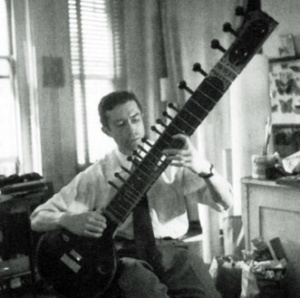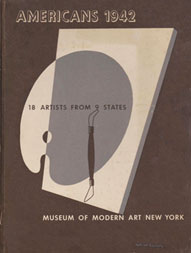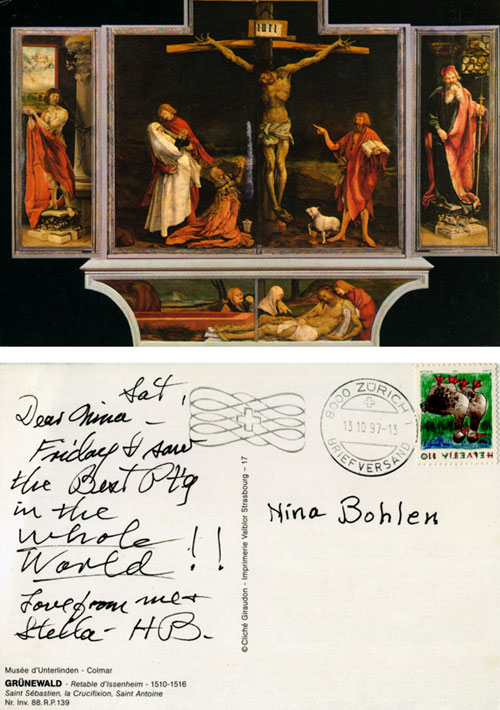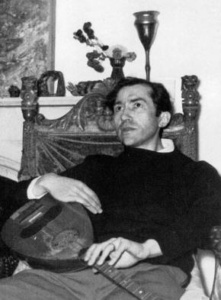Brief Biography
Hyman Bloom was born in Latvia in 1913. In 1920 Hyman left for the US with his parents and brother to join his 2 older brothers who had emmigrated and settled in Boston during the year of Hyman’s birth.
Bloom’s artistic gifts were recognized early and while in 8th grade he received a scholarship to attend classes for gifted students at Boston’s Museum of Fine Arts. At this time he also began studies with Harold Zimmerman, and he met fellow Zimmerman student Jack Levine, who was two years younger than Hyman. He was “discovered” at the age of 28 by Dorothy Miller, and his very first show was a group show at the Museum of Modern Art in 1942.
Time Magazine’s Arts Review column from February 02, 1942 entitled “Mass Debut” would be the first review — but hardly the last — to characterize Bloom as a reclusive artist with esoteric interests :
“The most striking discoveries in the Museum of Modern Art’s show were Boston’s 28-year-old Hyman Bloom and Seattle’s 31-year-old Morris Graves. Until the Museum’s Painting Curator Dorothy Miller dug him out of a hermit-like existence in a Boston slum, Latvian-born Hyman Bloom had been painting in solitary squalor in a little second-story studio. A lover of Oriental musk who beguiles his spare moments playing on the Arabian lute, Hyman Bloom loves to paint, with exuberant Oriental color, the gloomy, bearded rabbis and synagogue scenes that he remembers from his childhood. Uninfluenced by other U.S. artists, indifferent to both money and publicity, shy, mop-headed Bloom has seldom sold a picture, never had an exhibition.“
Bloom’s influences include Altdorfer, Grunewald, Caravaggio, Rembrandt, Blake, Bresdin, Redon, Ensor & Soutine. His favorite painting was Grunewald’s Isenheim Altarpiece. In 1997, Bloom and his wife Stella traveled to Europe and went to Colmar, France to view the Isenheim Altarpiece in person. He sent Nina Bohlen this Grunewald postcard after viewing the work.

Bloom was a self-taught scholar with deep interest in Eastern philosophy and music, as well as mysticism and Theosophy. Beginning in the 1930’s, he developed a passion for South Indian classical music. In 1960, he co-founded the PanOrient Arts Foundation along with James Rubin, and donated his large collection of rare 78 rpm recordings to the foundation. The recordings are now held in Harvard Univesity archives. Numerous photos from the 1950s show Bloom playing an instrument, usually a sitar.
His interest in Eastern philosophy, mysticism and music seemed to foreshadow cultural changes that would come about in the late 1950s and into the 60’s, when large numbers of a younger generation developed a fascination with Eastern philosophy, Indian music and, also, psychedelics. Bloom was one of the first individuals in the US to take LSD (April 24th, 1954), 6 or 7 years before Timothy Leary started his own Harvard based experiments with LSD. Bloom had many Harvard connections and his LSD experience was a formal medical experiment with Dr. Max Rinkel and Dr. Clemens Benda to assess the drug’s effect on creativity.
Bloom’s fame diminished after the 1950’s due to a variety of reasons: he never moved to New York, preferring to remain in Boston, he rejected pure abstraction at a point when the New York art world was just starting to champion pure abstraction (ironically, Jackson Pollock and Willem de Kooning referred to Bloom as “America’s first abstract expressionist”). He stopped painting for close to a decade beginning in the early 1960s and turned his attention exclusively to drawing, so he could more intently focus on value and composition.
Bloom’s paintings are wonderful explorations of light and color. Throughout his life he worked in large part within a relatively small set of themes, each wildly different in nature: Christmas Trees, Rabbis with Torahs, Landscapes, Fish “seascapes”, Still Lifes (pottery/gourds) and cadavers/autopsy scenes. The latter subject matter was obviously challenging, eliciting occasional outrage and charges of obscenity when the exhibitions toured the country. Bloom was unconcerned about critical response – he felt that the subject matter, while harrowing, was in fact beautiful and the feeling of boundaries transgressed perhaps added to the intensity that he always sought in a painting. There are unsettled questions regarding the sources of some of his imagery — what is certain is that Hyman Bloom lived a long productive life, never wavering from his artistic vision of exploring themes of physical and spiritual transformation, and in the process made substantial contributions to American art.
-Robert Alimi



